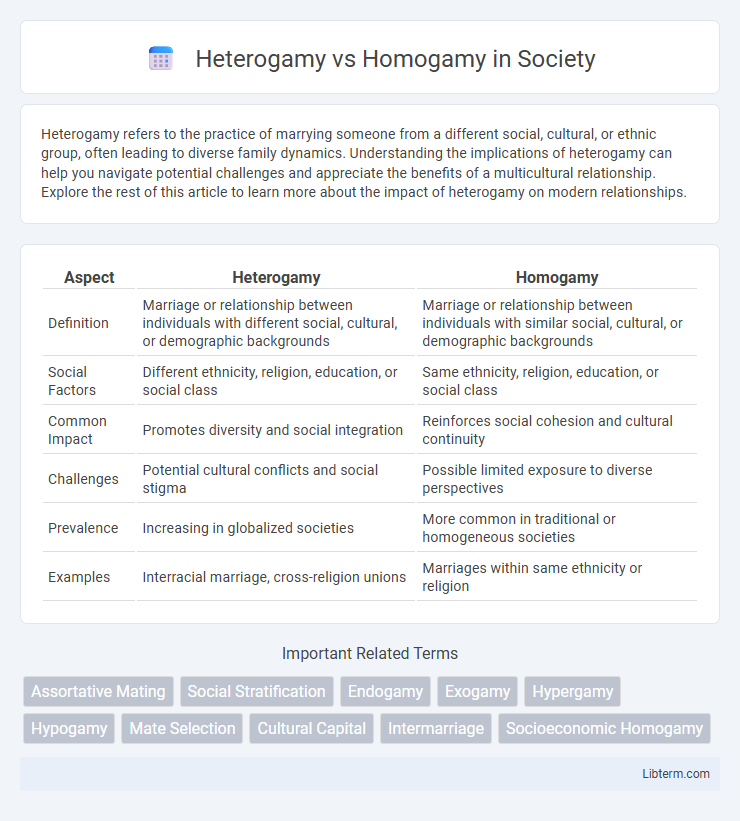Heterogamy refers to the practice of marrying someone from a different social, cultural, or ethnic group, often leading to diverse family dynamics. Understanding the implications of heterogamy can help you navigate potential challenges and appreciate the benefits of a multicultural relationship. Explore the rest of this article to learn more about the impact of heterogamy on modern relationships.
Table of Comparison
| Aspect | Heterogamy | Homogamy |
|---|---|---|
| Definition | Marriage or relationship between individuals with different social, cultural, or demographic backgrounds | Marriage or relationship between individuals with similar social, cultural, or demographic backgrounds |
| Social Factors | Different ethnicity, religion, education, or social class | Same ethnicity, religion, education, or social class |
| Common Impact | Promotes diversity and social integration | Reinforces social cohesion and cultural continuity |
| Challenges | Potential cultural conflicts and social stigma | Possible limited exposure to diverse perspectives |
| Prevalence | Increasing in globalized societies | More common in traditional or homogeneous societies |
| Examples | Interracial marriage, cross-religion unions | Marriages within same ethnicity or religion |
Introduction to Heterogamy and Homogamy
Heterogamy refers to the practice of marrying or forming relationships between individuals with differing social, cultural, or demographic characteristics, such as age, ethnicity, or socioeconomic status. Homogamy, in contrast, involves unions between individuals who share similar traits, including educational background, religion, or social class, promoting social cohesion and shared values. Understanding these patterns aids in analyzing social structures, mating preferences, and their implications on societal integration and diversity.
Definitions and Key Differences
Heterogamy refers to a marital or relationship pattern where partners come from different social, cultural, ethnic, or economic backgrounds, enhancing diversity and broadening perspectives. Homogamy involves partners who share similar characteristics such as race, religion, education, or socioeconomic status, promoting social cohesion and shared values. The key difference lies in the level of similarity between partners' backgrounds, influencing relationship dynamics and social integration.
Historical Perspectives on Marital Patterns
Historical perspectives on marital patterns reveal that homogamy, marrying within similar social, cultural, or ethnic groups, has been dominant in many traditional societies to preserve social cohesion and economic stability. Heterogamy, the union between individuals from different social or cultural backgrounds, historically faced resistance but increased with industrialization, urbanization, and globalization promoting greater social mobility. Sociological studies highlight these shifts as reflections of changing social norms and the gradual decline of rigid class and ethnic boundaries in marriage choices.
Socio-Cultural Influences on Partner Selection
Socio-cultural influences significantly shape partner selection through heterogamy and homogamy by driving preferences for similarities or differences in traits such as ethnicity, religion, education, and social class. Homogamy promotes social cohesion by encouraging unions within the same cultural or social groups, while heterogamy reflects openness to diversity and can challenge traditional social boundaries. Factors like family expectations, cultural norms, and societal values determine the prevalence of homogamous or heterogamous relationships in a community.
Psychological Impacts of Heterogamy and Homogamy
Heterogamy, involving partners from different social, cultural, or demographic backgrounds, often challenges individuals to develop greater emotional resilience and adaptability, which can enhance personal growth and interpersonal understanding. Homogamy, where partners share similar characteristics such as socioeconomic status or educational background, tends to offer psychological comfort and stability, reinforcing mutual values and reducing conflict. Both heterogamous and homogamous relationships affect mental health differently by influencing stress levels, communication patterns, and overall life satisfaction.
Economic and Educational Factors in Marriage Choices
Economic and educational factors critically influence marriage choices, distinguishing heterogamy from homogamy patterns. Couples practicing homogamy often share similar levels of income and education, which fosters economic stability and mutual understanding. Heterogamous marriages, involving partners with differing economic statuses or educational backgrounds, may experience diverse social dynamics but can also face challenges related to financial disparity and lifestyle differences.
Effects on Relationship Satisfaction and Stability
Heterogamy, involving partners with differing socioeconomic, cultural, or educational backgrounds, often introduces diverse perspectives but can lead to challenges in communication and shared values, impacting relationship satisfaction negatively. Homogamy, characterized by similarity in key social and personal traits, generally promotes higher relationship stability and satisfaction due to increased mutual understanding and aligned life goals. Research indicates that couples practicing homogamy report stronger emotional bonds and lower divorce rates compared to those in heterogamous relationships.
Trends and Statistics Worldwide
Heterogamy and homogamy represent patterns of partner selection based on differences or similarities in social, cultural, or demographic attributes, with recent trends showing a rise in heterogamous marriages, particularly in urban and multicultural societies worldwide. Statistical data reveals that homogamous marriages, where partners share similar education levels, socioeconomic status, or ethnic backgrounds, remain predominant in more traditional or rural regions, while globalization and increased mobility contribute to the growing heterogamy rates. Studies indicate that the frequency of heterogamous unions varies significantly by country, influenced by factors such as educational attainment, economic development, and social norms, highlighting a complex global landscape of mating preferences and marital patterns.
Challenges Faced by Heterogamous and Homogamous Couples
Heterogamous couples often face challenges related to cultural differences, conflicting values, and societal judgment, which can strain communication and mutual understanding. Homogamous couples may encounter difficulties due to shared entrenched habits or similar stressors, potentially limiting personal growth or conflict resolution diversity. Both types of couples must navigate unique relational dynamics that influence their adaptability and long-term relationship satisfaction.
Future Directions and Emerging Patterns
Future directions in the study of heterogamy vs homogamy emphasize the impact of digital dating platforms on partner selection, revealing patterns of increased cross-cultural and socioeconomic matches. Emerging research highlights the role of globalization and social mobility in reshaping traditional homogamous preferences toward more diverse unions. Predictive analytics and machine learning models are being developed to better understand evolving mate choice dynamics and their implications for demographic trends.
Heterogamy Infographic

 libterm.com
libterm.com